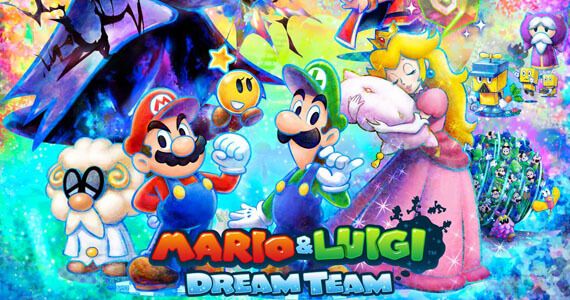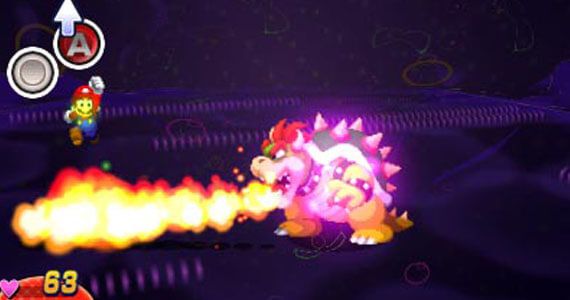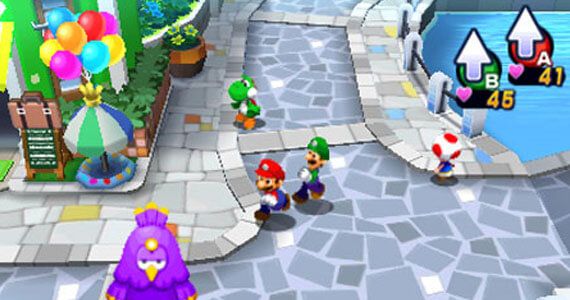There are few pairings as iconic as the Mario Bros., and the dynamic duo are teaming up once more in a brand new game for the Nintendo 3DS called Mario & Luigi: Dream Team. Once again placing the siblings in a new world with a heavy emphasis on RPG elements, the portable title will keep players immensely entertained with its slapstick humor, likable characters, impressive length, and engaging puzzles. While there's a lot to like about Mario & Luigi: Dream Team, the game has a habit of losing its pace and bouts with certain enemies have a tendency to become tedious. Read on for our review.
For those unfamiliar with previous iterations, the Mario & Luigi series is an RPG/platformer hybrid, filled with puzzle solving elements, turn-based combat, and unique mechanics that come from simultaneously controlling Mario and his often overlooked brother Luigi. Dream Team continues to provide a comparable experience to what's already available from the Mario & Luigi games that appeared on the DS and Game Boy Advance, but mixes up the standard gameplay by giving Luigi a more prominent role.
The game's story is based around a tourist's paradise known as Pi'illo Island, a mysterious area that was once inhabited by a race called the Pi'illos before they were mysteriously wiped out of existence. As the story progresses, players quickly find out that Luigi has the special ability to open up a portal to the dream world every time he nods off, thus establishing a brand new mechanic that paves the way for the biggest addition to the game itself — the option to alter the landscapes and bust out incredibly unique attacks within the dream world.
When Mario enters the dreams of his brother, he's joined by a metaphysical copy of his sibling called Dreamy Luigi. This version of Luigi, albeit not the real green-suited hero, isn't present within dream world battles as an additional fighter — instead opting to aid his big bro by powering up the pudgy plumber's stats and attacks. Luigi can also take on the form of certain items that are found within the background of each stage, which add unique puzzle scenarios for players to solve. These puzzles are often controlled by interacting with an unconscious Luigi on the bottom screen: pulling his mustache, grabbing his nose, or tapping his iconic hat.
The puzzles in the dream world alter so frequently that users will never grow tired of entering the alternate dimension, but there are plenty of other features in the dream world as well. Every dream that Mario enters changes the perspective of the traditional Mario & Luigi: Dream Team gameplay found when wandering around on Pi'illoh Island, effectively making each dream stage a 2D sidescroller. Mind you, standard RPG battles remain intact (so don't expect gameplay in line with New Super Mario Bros. U), but the title's formula changes immensely which makes for a nice change of pace from the hustling and bustling of the rest of the game.
While the dream mechanics are fun, the turn-based fights can become tiresome after several encounters with the same types of hostiles. Combat is similar to past iterations, with timed button presses during an attack dealing more damage and counter-attacks adding to the mayhem, but the droves of baddies rarely lets up. Every area has its own set of rapscallions that need to be dealt with, but encountering these enemy types over and over again is a massive drawback. Some bad guys have such tedious attacks that reversing them is either incredibly hard or just boring, which immediately takes players right out of the charming world that the developers at AlphaDream worked so hard to create.
The visual flair paints a beautiful world, and despite the 3D capabilities of the 3DS failing to contribute much to the overall experience, it manages to regain the attention of players who may be disenchanted with generic enemy encounters. It's a good thing it draws people in, because players will be spending a very long time on Pi'illo Island. The game can last upwards of 35-40 hours depending on how vigilant players are at conundrum conquering and baddie bashing. Couple the game's look with its laugh-out-loud dialogue and it becomes hard not to fall in love with the world of Dream Team.
Mario & Luigi: Dream Team falls short of greatness through poor pacing and redundant fights, but the good far outweighs the bad in what is a worthy installment in the Mario & Luigi series. The dream mechanics add an entirely new level of depth and enjoyment for users who've grown accustomed to the series' familiar formula, while the wacky humor and gameplay elements keep it in touch with the franchise's roots. Dream Team is a wonderful handheld game that'll entertain and engage players to the point where they'll, ironically, do anything but fall asleep.
-
Mario & Luigi: Dream Team is available now, exclusively on the Nintendo 3DS.
You can follow Riley on Twitter @TheRileyLittle.



